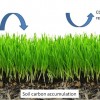 Native and improved pastures play an important role in sequestering carbon from the atmosphere. Because of the relatively high sequestration rates and extensive area, grazing land represents an important component of terrestrial carbon dioxide (CO2) offset and is a significant sink for long-term carbon sequestration and greenhouse gas mitigation. This 4-page fact sheet contains information for stakeholders, students, scientists, and environmental agencies interested in enhancing ecosystems services provided by grazing lands. Written by Maria Silveira, Ed Hanlon, Mariana Azenha, and Hiran M. da Silva, and published by the UF Department of Soil and Water Science, September 2012.
Native and improved pastures play an important role in sequestering carbon from the atmosphere. Because of the relatively high sequestration rates and extensive area, grazing land represents an important component of terrestrial carbon dioxide (CO2) offset and is a significant sink for long-term carbon sequestration and greenhouse gas mitigation. This 4-page fact sheet contains information for stakeholders, students, scientists, and environmental agencies interested in enhancing ecosystems services provided by grazing lands. Written by Maria Silveira, Ed Hanlon, Mariana Azenha, and Hiran M. da Silva, and published by the UF Department of Soil and Water Science, September 2012.
http://edis.ifas.ufl.edu/ss574